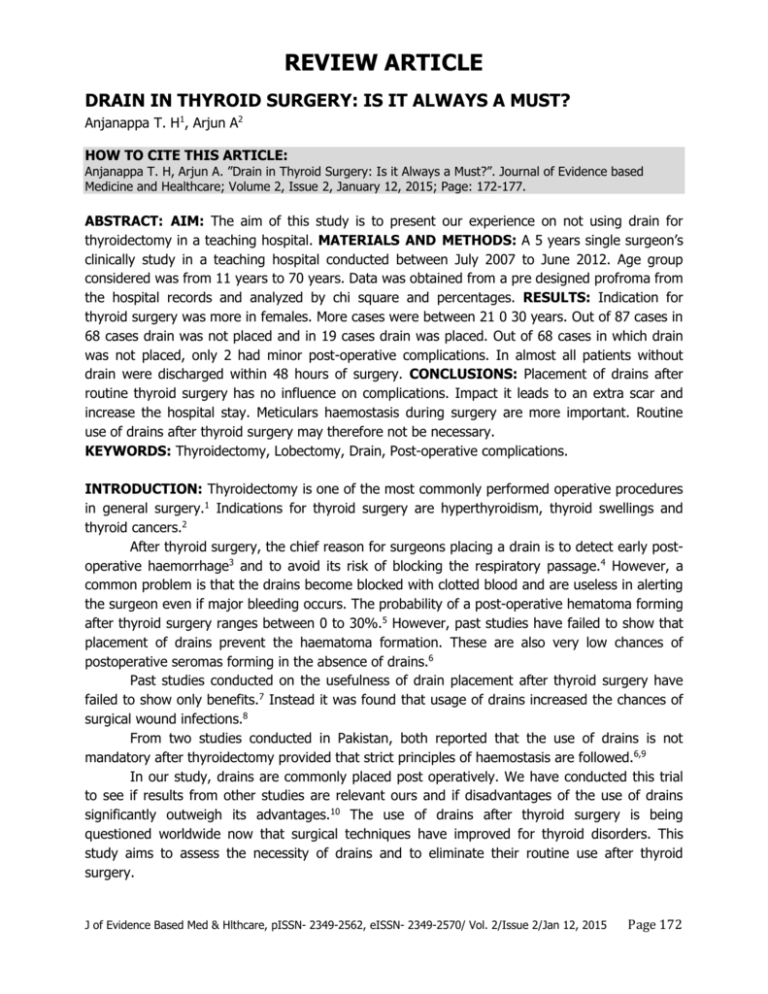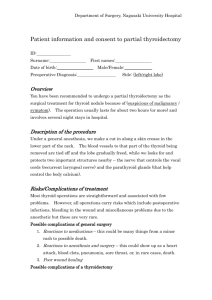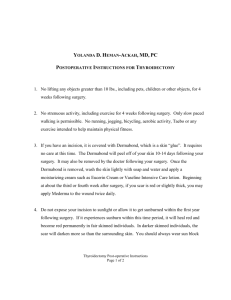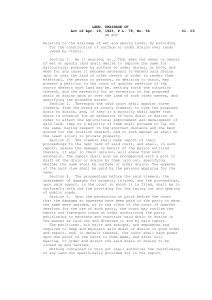drain in thyroid surgery: is it always a must?
advertisement

REVIEW ARTICLE DRAIN IN THYROID SURGERY: IS IT ALWAYS A MUST? Anjanappa T. H1, Arjun A2 HOW TO CITE THIS ARTICLE: Anjanappa T. H, Arjun A. ”Drain in Thyroid Surgery: Is it Always a Must?”. Journal of Evidence based Medicine and Healthcare; Volume 2, Issue 2, January 12, 2015; Page: 172-177. ABSTRACT: AIM: The aim of this study is to present our experience on not using drain for thyroidectomy in a teaching hospital. MATERIALS AND METHODS: A 5 years single surgeon’s clinically study in a teaching hospital conducted between July 2007 to June 2012. Age group considered was from 11 years to 70 years. Data was obtained from a pre designed profroma from the hospital records and analyzed by chi square and percentages. RESULTS: Indication for thyroid surgery was more in females. More cases were between 21 0 30 years. Out of 87 cases in 68 cases drain was not placed and in 19 cases drain was placed. Out of 68 cases in which drain was not placed, only 2 had minor post-operative complications. In almost all patients without drain were discharged within 48 hours of surgery. CONCLUSIONS: Placement of drains after routine thyroid surgery has no influence on complications. Impact it leads to an extra scar and increase the hospital stay. Meticulars haemostasis during surgery are more important. Routine use of drains after thyroid surgery may therefore not be necessary. KEYWORDS: Thyroidectomy, Lobectomy, Drain, Post-operative complications. INTRODUCTION: Thyroidectomy is one of the most commonly performed operative procedures in general surgery.1 Indications for thyroid surgery are hyperthyroidism, thyroid swellings and thyroid cancers.2 After thyroid surgery, the chief reason for surgeons placing a drain is to detect early postoperative haemorrhage3 and to avoid its risk of blocking the respiratory passage.4 However, a common problem is that the drains become blocked with clotted blood and are useless in alerting the surgeon even if major bleeding occurs. The probability of a post-operative hematoma forming after thyroid surgery ranges between 0 to 30%.5 However, past studies have failed to show that placement of drains prevent the haematoma formation. These are also very low chances of postoperative seromas forming in the absence of drains.6 Past studies conducted on the usefulness of drain placement after thyroid surgery have failed to show only benefits.7 Instead it was found that usage of drains increased the chances of surgical wound infections.8 From two studies conducted in Pakistan, both reported that the use of drains is not mandatory after thyroidectomy provided that strict principles of haemostasis are followed.6,9 In our study, drains are commonly placed post operatively. We have conducted this trial to see if results from other studies are relevant ours and if disadvantages of the use of drains significantly outweigh its advantages.10 The use of drains after thyroid surgery is being questioned worldwide now that surgical techniques have improved for thyroid disorders. This study aims to assess the necessity of drains and to eliminate their routine use after thyroid surgery. J of Evidence Based Med & Hlthcare, pISSN- 2349-2562, eISSN- 2349-2570/ Vol. 2/Issue 2/Jan 12, 2015 Page 172 REVIEW ARTICLE MATERIAL AND METHODS: A randomized clinical trial of diagnosed patients of goiter was conducted at K R Hospital, Mysore between July 2007 to June 2012. Cases were grouped into two groups, one with drain and other without drain placed post operatively. All cases of thyroid surgery were included. Cases were confirmed by all or at least two of the following tests; ultrasound of neck, fine needle aspiration of cytology, histopathology. Data was obtained from a predesigned profroma from the hospital records and analyzed by chi square test and percentages. Emphasis was given to six ration, age distribution, type of thyroidectomy, indication for placing drain and the complications in cases where drain was not placed. RESULTS: Out of 87 cases 13 were male (13 – 80%) and 74 were female (80.15%) with a ratio of 1:9. Out of the age group considered between 11 – 70 years, maximum cases were found between age groups 21 – 30 years (36.9%) and minimum cases were found between age groups 61 – 70 years (3.8%). Out of 87 cases, drain was not placed in 68 cases (73 – 84%) and drain was placed in 19 cases (26.15%). Maximum cases were drain not placed was in 2012 (20 cases). Maximum cases were drain was placed was in 2007 (12 cases). Out of 87 cases, solitary nodular thyroid (SNJ) was 44 (48.2%), Multinodular goiter (MNG) was 26 (32.3%), papillary carcinoma 16 (16.9%) and follicular carcinoma 1 (1.5%). Minimum time drain was placed in subtotal thyroidectomy (o cases, o%). Maximum time drain was placed in total thyroidectomy with modified radical neck dissection (2 cases, 100%). Mainly two complications were found even when drain placed. 1 case had hematoma and 1 case had would infection. In 1 case were drain was not placed patient had haematoma. Mean hospital stay without drain was 2 days and mean hospital stay with drain was 5 days. Mortality rate was 0 (0%). DISCUSSION: It is common practice for surgeons to routinely insert a drain after every case of thyroid surgery, whether it is total thyroidectomy or lobectomy. This is mainly due to the fear of post-operative haemorhage or accumulation of excess lymphatic fluid which needs to be drained as it can compromises the airway. Postoperative bleeding after thyroid surgery is reported to be as rare as 0.3 to 1%.11 In two studies of 250 and 400 patients no benefit of using drains after thyroid surgery has been documented.12,13 It has been observed that if correct surgical techniques and hemostatic procedures are followed, excessive post-operative bleeding can be avoided. Precautions such as staying within the subplatysmal plane during surgery and using coagulation diathermy along with proper ligation of bleeding vessels will reduce chances of postoperative hemorrhage. In real practice insertion of drain should be rationalized on the basis of the operative procedure performed and the extent of neck dissection along with patients to patient’s variation. Many authors recommend the use of drains only for complicated cases such as resection of substernal goiter, large dead space, raw thyroid bed14 or in hyper vascular diseases of thyroid (eg: grave’s disease) or certain carcinoma. J of Evidence Based Med & Hlthcare, pISSN- 2349-2562, eISSN- 2349-2570/ Vol. 2/Issue 2/Jan 12, 2015 Page 173 REVIEW ARTICLE A study showed that there was fluid collection in the surgical field regardless of the use of a drain, the reason being either the drain triggered inflammation and fluid formation itself or the negative pressure created by the drain sealed of the lymphatics16. In our present study, there were no cases of seroma formation in either the drain or non-drain groups, which coincides with the facts that seroma formation does not specifically occur when drains are not used. The insertion of drain after every thyroid surgery increases the risks of introducing infection into the patient. Post-surgical would management and aseptic techniques used during surgery also play a major role in determining the development of infection. Similarly, our study also suggests that insertion of drain after the thyroid surgery increases the hospital stay of the patients (5 days) as compared to the ones that were left without the drain (2 days). Placement of drains can also cause poor cosmetic results and create separate surgical scars. It also increases operating time by 5 – 10 minutes17. Other complications can include hypopara thyroidism, hypocalcaemia, voice change, stridor, dyspnea. The present clinical trial, in conformity with numerous international clinical trials, could not show only benefit of routinely placing drains after every case of thyroid surgery, particularly in complicated cases. CONCLUSION: In uncomplicated surgeries, especially in cases of lobectomy, use of drain can be omitted which will help decreasing chances of would infection, with substantial shortening of patient stay while increasing patient comfort and satisfaction. REFERENCES: 1. Jabsin C, Jamer A, Ozgur J, Hakan C, Bora U, Arzu K, et at. Drinage after total thyroidectomy or lobectomy for benign thyroidal disorders. J Zhejiang Univ Sci B 2008 9 (4): 319 – 323. 2. Prichard Rs. Murphy R, Lowry A, Mchaughlin R, Malone C, Kerin M J, The routine use of post-operative drains in thyroid surgery, an outdated concept in Med J 2010, 103 (1): 26-27 3. Wihlborg O, Bergling L, Martensson H: To drain or not to drain in thyroid surgery. A controlled clinical study, Arch surg 1988, 123 (1): 40 – 41 4. Khanna J, Mohil Rs, Chintamani D, Dinesh B, Mittal MK, Sahoo M et al: is the routine dramage after surgery for thyroid necessary? A prospective randomized clinical study, MBC seng 2005, 19: 5 – 11 5. Lee SW, Choi EC, Lee YM, Lee JY, Kim SC, Koh YW: Is lack of placement of drains after thyroidectomy with central neck dissection safe? A prospective randomized study, Laryngoscope 2006, 116(9): 1632 – 1635. 6. Gooda MR. Onwala 29, Khan S: use of dramage after thyroid surgery; is it evidence bared? Pak J Surg 2007, 23 (3); 173 – 176 7. Chalya Pt, Gilyoma JM, Mchembe M: Drain virus also drain after thyroidectomy: a prospective Randomized clinical study. East ant Afr J surg 2011, 16(22): 55 – 61 J of Evidence Based Med & Hlthcare, pISSN- 2349-2562, eISSN- 2349-2570/ Vol. 2/Issue 2/Jan 12, 2015 Page 174 REVIEW ARTICLE 8. Ozlem N, Ozdogan M, Gurer A, Gomali 1, Aydin R: should the thyroid drain be drained after thyroidectomy? Longinbecks archives of surgery Deutsch Qesellschalf fur Chirugie 2006, 391 (3): 228 – 230 9. Ishaq 1, Iqbal J, Ajmal R, Alzal M, Munir K: The role of drainage after thyroid surgery. Is it mandatory? A.P.Ta. C. 2008, 2 (1):46 – 49. 10. World Medical Association, Inc WMA Declaration of Helsinki; 2009. http://www.wma.net/in/30 publications/10 policies/b3/index.html. 11. Calopa, Pisana G, Piga G, Medas F, Jatti A, Donati M, Nicolosi A, Postoperative hematomas after thyroid surgery. Incidence and risk factors in our experience, Ann ital chir, 2010, 81: 343 – 437. 12. Arriyanayagam DC: Narayana Singh V, Bosby D, Sieunashine K, Raju 9: Thyroid surgery without dramage, 15 years of clinical experience. J Roy call sarg Edirib, 1993, 38: 69-70 13. Shaha AR, Jaffe Btn: selective use of drains in thyroid surgery. J Surg oncd 1993: 52 (4): 241 – 3 14. Schore sanitis a, Melissas J, Sanidas E, et al: Does draining the neck affect morbidity following thyroid surgery? Am Surg 1998, 64: 778 – 780 15. Hurtado – Lopez Lm, Lopez – Romero S, Rizzo – Fuentesc, it at selective use of drains in thyroid surgery, Head neck 2001, 23: 189 – 193 16. Khanzada TW, Samad A, Mimon W, Kumar B: Post thyroidectomy complications: the Hyderabad experience, J Ayub Med Coll Abborebad 2010, 22 (1): 65 – 68. 17. Sulsu N, Vural S, Onul M: Is the insertion of drains after uncomplicated thyroid surgery always necessary? Serg Today 2006, 36(3): 215 – 218. Sex No. of cases % Male 13 13.80 Female 74 86.15 Table 1: Total number of cases sex wise Age in years No. of cases 11 – 20 5 21 – 30 31 31 – 40 29 41 – 50 16 51 – 60 3 61 – 70 3 Total 87 % 6.15 36.9 29.2 20 3.8 3.8 100.0 Table 2: Age wise distribution of cases J of Evidence Based Med & Hlthcare, pISSN- 2349-2562, eISSN- 2349-2570/ Vol. 2/Issue 2/Jan 12, 2015 Page 175 REVIEW ARTICLE Drains Placed Not placed Total Number 19 68 87 3. Drains Percentage 26.15 73.84 100.0 J of Evidence Based Med & Hlthcare, pISSN- 2349-2562, eISSN- 2349-2570/ Vol. 2/Issue 2/Jan 12, 2015 Page 176 REVIEW ARTICLE AUTHORS: 1. Anjanappa T. H. 2. Arjun A. PARTICULARS OF CONTRIBUTORS: 1. Dean and Professor, Department of General Surgery, Sambhram Institute of Medical Sciences and Research, K. G. F. 2. Assistant Professor, Department of General Surgery, Sambhram Institute of Medical Sciences and Research, K. G. F. NAME ADDRESS EMAIL ID OF THE CORRESPONDING AUTHOR: Dr. Anjanappa T. H, No. 1179, 6th Main, 17th Cross, ‘A’ Block, 2nd Stage, Rajajinagar, Bangalore-560010. E-mail: anjanappath@yahoo.co.in Date Date Date Date of of of of Submission: 07/01/2015. Peer Review: 08/01/2015. Acceptance: 09/01/2015. Publishing: 10/01/2015. J of Evidence Based Med & Hlthcare, pISSN- 2349-2562, eISSN- 2349-2570/ Vol. 2/Issue 2/Jan 12, 2015 Page 177






